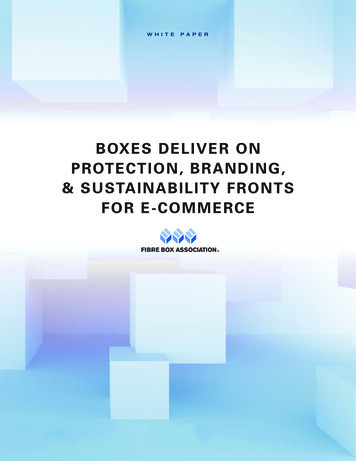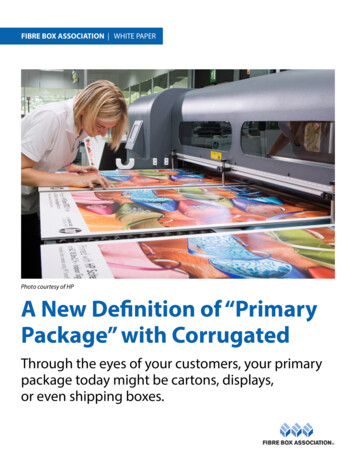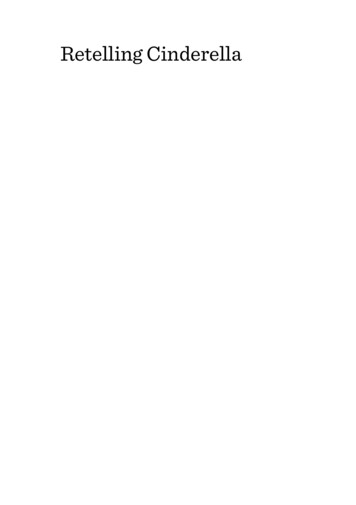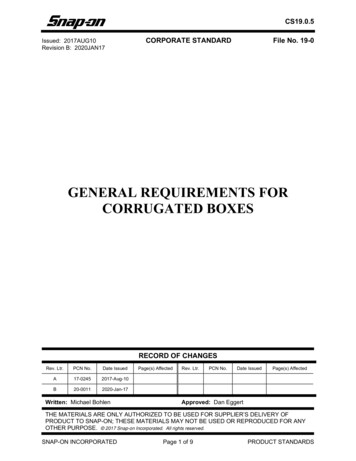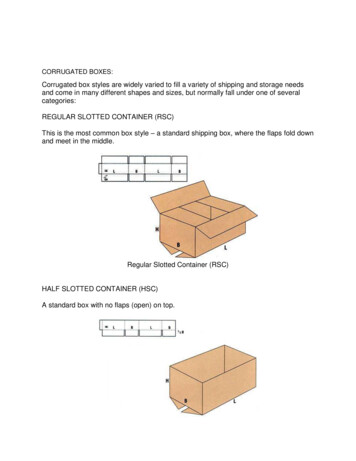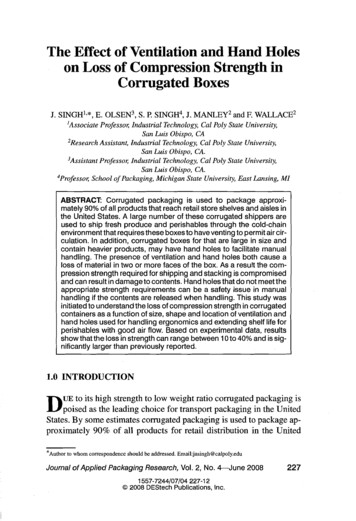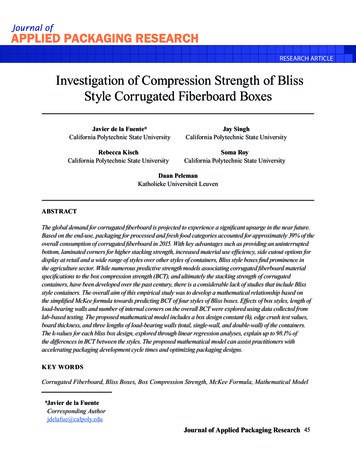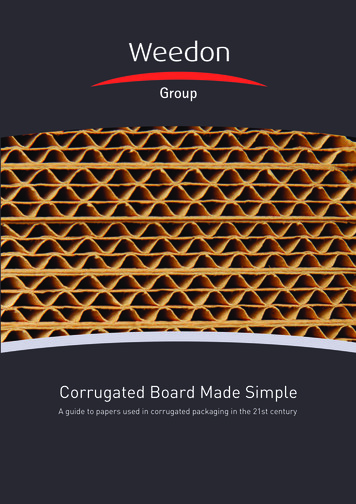
Transcription
Corrugated Board Made SimpleA guide to papers used in corrugated packaging in the 21st century
The type of paper used to make the corrugated boardused in packaging is a key factor in determining theperformance of that packaging. Of course it is not theonly factor. For example, it is important that thebox-maker has installed modern conversionequipment with a kiss touch, which does not crush orweaken the board. And structural design – an area inwhich the Weedon Group has particular expertise – isalso crucial.In the old days, it was simple – it was all a matter ofweight. The heavier the paper, the stronger the boxproduced from it. Today, with the development ofpaper-making, the type of paper can make asignificant difference to performance too. Nowadays,lighter papers can – and do – perform as well andeven better than heavier papers – with less damageto both budget and the environment!The environment is another issue to consider whenspecifying paper. Is corrugated packaging a goodchoice in terms of the welfare of our planet? Doesrecycled board perform as well as board made fromvirgin fibres?This guide charts the evolution of corrugatedpackaging board, and introduces the different typesof paper used to make corrugated board today andtheir characteristics. The glossary at the endexplains some of the jargon.Choosing the right board for packaging today is notsimple. But we in the Weedon Group have thespecialists who can advise you and we are alwayshappy to help. We even have our own in-housetesting facility so we can try out proposed materialsand prove a design will deliver before we go intoproduction.Paper – some interesting facts Paper is a versatile material. As well as theobvious uses, such as writing, printing andpackaging, it can even be an ingredient infood – particularly in Asian cultures. Paper, and the pulp paper-making process,were said to be developed in China during theearly 2nd century AD, possibly as early as theyear 105 AD by the Han court eunuch, CaiLun, although the earliest archaeologicalfragments of paper derive from the 2ndcentury BC. The modern pulp and paper industry isglobal, with China leading world production.Let’s start with the basicsWhat is paper?Paper is usually produced by pressing togetherthe moist fibres of cellulose pulp derived fromwood, and drying them into thin, flexible sheets.The type of fibre used determines theperformance of the paper produced.Paperboard is generally thicker than paper(usually over 220 gsm). It can be single- ormulti-ply. Sometimes it is referred to ascardboard, which is a generic, lay term used torefer to any heavy paper pulp-based board. Thetype of paper used determines the performanceof the board.What is corrugated board?Corrugated board consists of one or moresheets of fluted paper (the corrugatingmedium) stuck between flat sheets of paper orboard (the liners or linerboard). Because of itsconstruction, it is stronger than flat board.
I A Brief History of Corrugated Board in PackagingThe early daysThe history of corrugated board used in packaginggoes back further than you might have expected.When it was first launched, Victoria was on thethrone, the first cricket Test match was being playedin England and Britain was fighting the Boer War!In the 1880s the first corrugated packaging boardsemerged, but they used materials produced for othertypes of packaging: bag papers for liners andstrawboard for fluting. And they were mostlyproduced on machines built to manufacture othergrades of paper such as writing papers or newsprint.The raw materials used were usually virgin fibre,unbleached wood pulps and straw pulp.The introduction of corrugated boardinto packaging 1817 – the first paperboard carton wasproduced in England 1860s – folding cartons first emerged andwere shipped flat to save space 1879 – the development of mechanical diecutting and creasing of blanks 1880s – establishment of commercialoperations producing corrugated board andpackaging by Thompson and Norris, theemergence of corrugated board forpackaging 1950s – UK production of corrugatedpackaging board passed a quarter of amillion tonnes 1980s – UK production passed 1.5 milliontonnes Mid-1990s – UK production passed 2 milliontonnes 2001 – UK production passed 2.3 milliontonnesIn the 1970s, the fuel crisis, with a consequent rise inenergy prices, and growing environmental legislationpushed up the price of Kraft liners and SemiChemical fluting. This led to a further growth in theuse of substitute materials using recycled fibreproducts – Waste-based fluting and Test-liners.Over the next couple of decades, progress incorrugated board manufacture included theintroduction of chemical additives, waste paperpulping equipment and paper-making machines withmulti-ply forming. By the turn of the millennium,85-90% of corrugated packaging board used inEurope was produced using recycled fibres. Someparts of the world now use almost 100% recycledfibres.Of the fibres used to make paper in the UK, over 70%now come from paper collected for recycling byhouseholds and businesses. The rest come mainlyfrom virgin wood fibre from trees grown insustainably managed and certified forests. Paperfibres can only be recycled up to about seven timesas they eventually degrade in the recycling process,losing their paper-making qualities. The degradedfibres are replaced with new virgin fibres, either fromtrees or more often from recovered paper that hasnot previously been recycled.The growth of recycled corrugatedpackaging boardDuring World War II, increasing quantities of wastepaper were used to make corrugated board(recycling is not new!), but the results were of poorquality. After the War, new large pulp and paper millswere built specifically to produce Kraft liner andSemi Chemical fluting for the corrugating industry.However, waste paper had gained a foothold that ithas never lost. During the 1950s, waste paperconsumption started to increase in Europe, mainlydue to developments which enabled starch to beincorporated in the papers to improve strength andstiffness.1
II The Different Types of Corrugated Case MaterialsVirgin fibresSecondary (recovered) fibresFor liner boardKraft linerTest-linerFor flutingSemi Chemical flutingWaste-based fluting1 Virgin fibre productsVirgin fibre – wood fibre that has never been usedbefore to make pulp, paper or board, ie it does notinclude any recycled fibres.By the 1950s, corrugated packaging production wasa major industry and was consuming increasingamounts of paper. The paper industry around theworld – particularly in the USA and Scandinavia –responded by ramping up production of corrugatedboard from wood pulp. Probably for the first time,new pulp and paper mills were designed and builtspecifically to produce virgin fibre-based corrugatedboard products.Stiffness – one of the most importantproperties of paperboard, as it affects both therunnability of the board during manufacture ofthe cartons and also the ability of cartons torun smoothly through the machine that erects,fills and closes them. Stiffness also givesstrength and reduces the likelihood of a cartonbulging under the weight of its contents.Although most paper strength propertiesincrease with increasing sheet density,stiffness does not. Other factors which affectboard stiffness include coatings and moisturecontent.There are two types of virgin fibre product used in themanufacture of corrugated board: Kraft liner – is a virgin fibre product made fromsoftwood pulp, produced by a process known asKraft pulping. This process uses sodium sulphateto treat softwoods, principally pine, to dissolve thebonding compound in the wood (lignin). This allowsthe cellulose fibres to be separated to form a woodpulp with little mechanical effort. These fibres arerelatively long because the original wood issoftwood, so the resulting paper is fairly stiff andhas good tear and bursting strength. This makes itideal for liners on corrugated board. Semi Chemical fluting – is produced from ahardwood pulp, ie where the cellulose fibres are2relatively short. It is produced by a sulphite bondingprocess which only partly dissolves the bondingmaterial, lignin, so a significant amount is retained.This produces fibres with low flexibility and a densepaper which is very stiff and has a highcompression strength. In addition, when passedthrough a corrugator, heat reacts on the ligninwhich sets very rigidly when it cools in the formedflute, bonding the fibres together to produce a veryrigid board with good crush resistance.2 Secondary fibre productsSecondary fibre – Fibre that has been used before,eg recovered paper.As well as increased demand, several factors havedriven the growth of secondary fibres in corrugatedboard including: Their low cost as a raw material Environmental issues such as the reduction inpollution and the potential for recycling The widespread availability of waste paper A lower capital cost for the construction of plant toproduce waste paper pulp Lower energy costs for their operationThere are basically two categories of recoveredpaper used in corrugated packaging, each withdifferent characteristics: Waste-based fluting (WBF)and Test-liners. Waste-based fluting – Starch is added to improvethe stiffness of Waste-based fluting. Starchperforms the same function as lignin in SemiChemical fluting. Test-liners – Used as the outer layer of corrugatedboard, made partly from chemical pulp and partlyfrom waste paper.Today there are two grades: Test-liner 2 (partlyrecycled liner paper) and Test-liner 3 (fully recycledliner). In the main, Test-liner 2 matches Kraft linerin all respects except bursting strength, so is nowwidely used as an outside liner on board forcorrugated cases where puncture and waterresistance is not a key requirement.
III The Characteristics of Corrugated Board1 Virgin v. recovered fibre boards – how dothey compare?Fluting: At the lower grammage levels, Waste-based flutinghas been developed to a level close to SemiChemical fluting. Above 150 gsm, Semi Chemicalperforms better.Liner: Kraft liner has a superior bursting strength, withTest-liner 2 achieving about 70% of the Kraft linerlevel. When it comes to compression strength, Test-liner2 achieves about 90% of Kraft liner levels andTest-liner 3 about 50%. The internal fibre bonding strength of Test-liners isvery similar to Kraft liner and at a level whichmeets industry requirements. The smoothness of Test-liner 2 is almost as goodas Kraft liner and within the range needed to printon brown liners.2 The different fluting profilesFluting – the corrugating medium that is covered onone or both sides by flat papers (or liners) to makecorrugated board.Corrugated board is available in many differentwidths with varying paper weights and finishes.Fluting ranges in terms of the number ofcorrugations (the waves or arches) per unit lengthand height.Flute ‘profiles’ (sizes)Flute profileFluting heightCharacteristics and usesB-flute3mmGood puncture resistance.Most common type of fluting. Seen in all types ofapplications including die-cut and regular cases, givesa good all-round performance.C-flute4mmVery common grade.Offers greater compression strength than B-flute, withslightly better stacking strength for lighter products. Itcan be prone to more crushing if used in the wrongapplication.E-flute1.8mmLight-weight fine flute (it is one quarter the thickness ofC-flute).Provides a flat surface for high quality printing.Excellent crush resistance and compression strength.Most commonly used in smaller cartons and die-cutapplications.F-flute0.75mmExtra thin.Commonly used for packaging of luxury products,which is to be litho-laminated.Less-fluteWeedon’s own range ofenvironmentally friendly,economical board grades.Also known elsewhere asR-flute, S-flute or X-flute.2mmParticularly suited to the Retail Ready Packagingmarket.The board is thinner – without forfeiting strength – andtherefore more efficient in production and reducessupply chain costs. It also offers a better surface forprinting.3
Double wall combinationsLiners and fluting medium can be combined toproduce single wall board, double wall board or eventriple wall board: Single Wall Board – 2 liners and single flute Double Wall Board – 3 liners and double flutes Triple Wall Board – 4 liners and three flutesThe fluting of double wall board can be made ofdifferent paperboards, giving rise to combinationssuch as: BC double wall – 7mm in thickness, gives excellentall round performances, most often seen inshipping cases where a high protection level isrequired. EB double wall – 4.8mm in thickness, givesexcellent performance in both print finish andimpact protection. LE double wall (Less-flute combined with E-flute) –3.8mm in thickness, offers the Point of Sale displaymarket a fully recycled display board grade, whichis also more space-efficient than the traditional EBoption.3 Measuring the performance ofcorrugated boardsDetermining the strength of corrugated board is nowno longer simply a matter of judging its weight or itsthickness. A better indicator of potential strength isthe bendability of the linerboard.It’s all a matter of science!Research at the Institute of Paper Science andTechnology in Atlanta, GA, has shown thatcrush resistance is not significantly affected bythe weight of the board.The introduction of more advanced conversionmachinery is producing corresponding progress inthe development of new boards. Today’shigh-performance, light-weight boards haverelatively low bending stiffness and thus lesstendency to collapse under pressure. As a result, athinner board may now offer the same or even betterstrength and protection than a heavier board. Theimplications for materials usage and supply chaincosts are significant.4Tests which measure the performance of paperboardare therefore increasingly important. A battery oftests is now available:For flutings Concora Medium Test (CMT) – a stiffness test thatmeasures the crush resistance of the fluting Ring Crush Test (RCT) – a stiffness test to identifywhat the fluting contributes to the compressionstrength of the board (ie how much load it canwithstand before it collapses) Short Span Compression Test (SCT) – a moremodern form of RCTFor liners Bursting strength test (how much pressure papercan tolerate before it ruptures) RCT and SCT – to indicate the liner’s contribution tothe compression strength of the board Cobb test – to measure water absorbency of thetop surface, which affects printability. On the backsurface the same test indicates how well the linerwill adhere to the fluting The top surface is also tested for smoothness andshade level, which affect printability Tests for substance and moisture consistency andthe ability to fold without cracking
IV Environmental ConsiderationsWhy choose corrugated packaging?Contrary to popular opinion, corrugated packaging iswidely recognised in professional circles as the mostenvironmentally friendly form of packaging availabletoday.For example, some believe that the world’s forestsare being decimated to make paper.FACT: The virgin fibres for corrugated board mostlycome from sustainably managed forests that existsolely for the materials they provide, thoughpaper-making also provides a convenient outlet forlow-grade wood resulting from essential forestmanagement.FACT: New forests are being planted rather thandestroyed. For every tree cut down, three to four arereplanted, and it is estimated that there are 25%more trees in the developed world today than therewere in 1901.All cardboard can be reused and recycled. Recycledcorrugated cardboard can be used to make morecardboard boxes. This means that less resources areused in the future, and re-use of boxes ensures themaximum lifespan of the original materials.Corrugated cardboard has a recycling rate of 84% inthe UK – the highest recycling rate of any type ofpackaging. Every four months, an area the size ofGreater London is saved from landfill by recyclingcorrugated cardboard alone!Other reasons to consider recycled board: Recycled materials generally cost less than virginmaterials. Many consumers now base their purchasing habitson how eco-friendly a product and its packagingappear to be.FACT: The production of recycled corrugated boardconsumes not only recycled packaging waste butalso conveniently disposes of other types of wastepaper. Recovered paper (used paper) representedover 70% of the fibre used to manufacture paper andboard in the UK in 2013.This figure will never acheive 100% for two mainreasons: Waste corrugated can only be recycled seven timesbefore its fibre becomes too weak for further use(but even these unusable fibres are fullybiodegradable). Paper and cardboard is lost when used, forexample, in books or wallpaper, when destroyed inuse or contaminated (think cleaning materials andtoilet paper!).5
V The Future?Paper and board technology is improving all thetime. One of the key trends likely to develop incoming years is the growth of ‘light-weighting’ – themove towards ever lower grammage corrugatedboard, possibly as low as 70-80 gsm.Minimising the use of raw materials in this way willhelp sustain corrugated board as a packagingmaterial. It will drive down prices to the customerand help address growing environmental concerns.The key is the achievement of the same strength andprotection from thinner boards – and we are alreadyseeing this today with the introduction of a newgeneration of light-weight boards such as our ownLess-flute.If buyers only know one fact about choosing the rightboard for a job, it is that they should now beconsidering strength and performance rather thansimply ‘weight’.6
VI Appendix – GlossaryTerminology and classifications of paperboard arenot always uniform. Differences occur depending onspecific industry, geographical location and personalchoice. However, the following terms are often used:Bleaching – pulp used in the manufacture ofpaperboard can be bleached to decrease colour andincrease purity. Virgin fibre pulp is naturally brown incolour. Recycled paperboard may contain traces ofinks, bonding agents and other residue which colourit grey. Although bleaching is not necessary for allend-uses, it is vital for many graphical andpackaging purposes.Bursting strength – how much pressure paper cantolerate before it ruptures.Compression strength – how much load paper canwithstand before it collapses.Conversion equipment – the machinery whichconverts corrugated board into boxes.Corrugated board – consists of fluted paper (or‘corrugating medium’) stuck to one or two flat sheetsof paper or board (called liner or linerboard). Singleface corrugated is where one sheet of fluting is stuckto one liner board; double face corrugated board ismade up of a sheet of fluting stuck between twosheets of liner. Since corrugated board is mademainly out of natural unbleached wood fibres, it isgenerally brown, although its shade may varydepending on the type of wood, pulping process,recycling rate and impurities content. For certainboxes that demand good presentation, whitebleached pulp or coating is used on the top ply of thelinerboard that goes on the outside of the box.Corrugating medium – the paper used to form thefluted part of corrugated board.Corrugator – the machine that makes corrugatedboard from fluting and liner papers.Die-cut – stamping out a box shape using steel ruledies (like cutting out biscuits with a pastry cutter!).Double wall board – corrugated board comprisingliner/flute/liner/flute/liner.Flute – a single ridge (arch) in the fluting medium.Fluting – the corrugating medium that is covered onone or both sides by flat sheets (or liners) to makecorrugated board.technically paper is measured by its thickness,people still talk (inaccurately) about its ‘weight’.Hardwood – eg birch, which has short fibres (approx.1.3mm in length). Generally more difficult to workwith, it provides higher tensile strength, but lowertear and other strength properties. Although itsfibres are not as long and strong as those insoftwood, they make for a stiffer product. Hardwoodfibres fill the sheet better and therefore make asmoother paper that is more opaque and better forprinting. Hardwood makes an excellent corrugatingmedium for fluting.Kraft liner – is made from virgin fibre from softwoodpulp, produced by a process known as Kraft pulping.This process uses sodium sulphate to treatsoftwoods, principally pine, to dissolve the bondingcompound in the wood (lignin), allowing the cellulosefibres to be separated to form a wood pulp with littlemechanical effort. These fibres are relatively longbecause the original wood is softwood, so theresulting paper is fairly stiff and has good tear andbursting strength, making it ideal for liners oncorrugated board.Lignin – found in plants, acts as a binding agent orcement between the fibres in wood and other plants,making them rigid.Liners/Linerboard – in corrugated board, a strongstiff board covering one or both sides of thecorrugating medium (fluting). The liner provides thepuncture and tearing strength requirement, toprotect the contents of the corrugated case. Specialcoatings may be applied for specific usage includingmoisture-repelling and anti-static.Multi-ply – made from a number of layers of pulpedfibres. Multi-ply paperboard generally creases andfolds better than single-ply.Paper – a thin material produced by pressingtogether moist fibres (typically cellulose pulp derivedfrom wood, rags or grasses) and drying them intoflexible sheets.Paperboard – a thick paper-based material. Whilethere is no rigid differentiation between paper andpaperboard, paperboard is generally thicker.According to ISO standards, paperboard is a paperthat is heavier than 224 gsm, but there areexceptions. Paperboard can be single- or multi-ply.Sometimes it is referred to as cardboard, which is ageneric, lay term used to refer to any heavy paperpulp-based board.Grammage – mass per unit in gsm (grams persquare metre), a measure of paper density. Although7
Pulp – a lignocellulosic fibrous material prepared bychemically or mechanically separating cellulosefibres from wood, fibre crops or waste paper.Pulping – extracting fibres from their sources.Recycled paper – paper made from extracting usedpaper fibre.Runnability – how well a paper performs on press.Considerations of a paper's runnability include avariety of structural and surface properties, such ascleanliness of the surface, how well particles offillers and coatings remain bonded to the paper, howwell a paper maintains its dimensional stability(changes in size due to changes in moisture contentcan affect not only the quality of the printed image,but also cause feeding problems), and other factorssuch as curling, wavy edges and chemicalcomposition.Secondary fibre – fibre that has been used before, egrecovered paper.Semi Chemical fluting – produced from a hardwoodpulp, ie where the cellulose fibres are relativelyshort. A significant amount of the bonding material,lignin, is retained. This produces a very stiff paperwith high compression strength. In addition, whenpassed through a corrugator, heat reacts on thelignin which sets rigidly when it cools in the formedflute, bonding the fibres together to produce a veryrigid board with good crush resistance.Sheet plant – a corrugated box manufacturer thatconverts sheet board into packaging.Single face – one piece of corrugated fluting glued toone liner.Single wall – corrugated board comprisingliner/flute/liner.Smoothness – the flatness of the surface. It candetermine whether or not the paper can besuccessfully printed.Softwood – eg pine and spruce, which have typicallylong fibres (approx. 3.3mm in length) and makesuperior paperboard for use where strength isimportant. Softwood makes excellent linerboard.8Stiffness – the measure of force required to bend apaper through a specified angle. This is one of themost important properties of paperboard as it affectsthe runnability of the board during manufacture ofthe cartons and also the ability of cartons to runsmoothly through the machine that erects, fills andcloses them. Stiffness also gives strength andreduces the likelihood of a carton bulging under theweight of its contents such as, for example, cerealssettling in the box. Although most paper strengthproperties increase with increasing sheet density,stiffness does not. Other factors which affect boardstiffness include coatings and moisture content.Straw pulp – an alternative to wood pulp in themaking of paper. Non-wood fibre sources account forabout 5-10% of global pulp production.Tearing resistance/strength – the ability of thepaper to withstand a tearing force. Fibre length andinter-fibre bonding are both important factors intearing strength. Longer fibres (from softwood)deliver greater tear strength.Tensile strength – resistance to the force required toproduce a rupture in a strip of paper or paperboard,affected by fibre strength, fibre bonding and fibrelength.Test-liners – liners made partly from chemical pulpand partly from waste paper.Virgin fibre – wood fibre that has never been usedbefore to make pulp, paper or board, ie it does notinclude any recycled fibres.Waste-based fluting – normally fluting made from100% recycled paper. In the UK most WBF producedis in the lower board weights.Wet strength – some grades of paper have to bestrong enough to withstand tear, rupture or fallingapart when saturated with water. To impart wetstrength, the paper is treated chemically or thepackaging is coated.Wood pulp – wood fibre reduced chemically ormechanically to pulp and used in the manufacture ofpaper.
Copyright Weedon PSC 20141/0814
Weedon Group LtdAnglesey HouseAnglesey Business ParkLittleworth RoadHednesfordStaffordshireWS12 1NR01543 423838Email: peaceofmind@weedonpsc.comWeedon PSC Ltdwww.weedonpsc.comi2i europe Ltdwww.i2ieurope.comWeedon CorrugatedProducts Ltdwww.weedoncp.com
box-maker has installed modern conversion equipment with a kiss touch, which does not crush or weaken the board. And structural design - an area in . In the 1880s the first corrugated packaging boards emerged, but they used materials produced for other types of packaging: bag papers for liners and strawboard for fluting. And they were mostly
